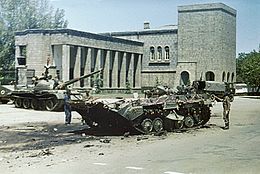| Rivoluzione di Saur parte della guerra civile afghana | |
|---|---|
 | |
| Data | 28 aprile 1978 |
| Luogo | Afghanistan |
| Esito | Abbattimento del regime di Mohammed Daud Khan instaurazione della Repubblica Democratica dell'Afghanistan |
| Schieramenti | |
| Comandanti | |
| Voci di colpi di Stato presenti su Wikipedia | |
Rivoluzione di Saur (in lingua pashtu انقلاب ثور), anche detta Rivoluzione d'aprile o Rivoluzione d'aprile afghana, è il nome dato al colpo di stato in Afghanistan da parte del Partito Democratico Popolare dell'Afghanistan (PDPA) avvenuto il 27 aprile 1978. La parola dari "Saur" si riferisce al nome del secondo mese del calendario persiano, il mese in cui questo ebbe luogo.[1] Il presidente afghano Mohammed Daud Khan venne destituito dopo cinque anni di governo e ucciso il 28 aprile 1978 da ufficiali militari a favore del PDPA.[2][3]
Il rovesciamento del governo fu deciso da Hafizullah Amin membro del PDPA, che poi sarebbe diventato una figura significativa nel governo rivoluzionario; in una conferenza stampa a New York nel giugno 1978, Amin affermò che l'evento non era un colpo di stato ma una rivoluzione per "volontà del popolo".[4] Il colpo di stato si sviluppò con pesanti combattimenti e morti [5]e portò alla creazione della Repubblica Democratica dell'Afghanistan con Nur Mohammad Taraki come presidente.
- ^ Barnett R. Rubin, The Fragmentation of Afghanistan, Yale University Press, 2002, pp. 104-105, ISBN 9780300095197.
- ^ Sanguinoso colpo di stato abbatte il regime di Daoud in Afghanistan (PDF), in l'Unità, 28 aprile 1978, p. 14.
- ^ (EN) Mohammad Daud Khan, su Afghanland.com, 2000. URL consultato l'11 marzo 2018 (archiviato dall'url originale il 17 agosto 2017).
- ^
 (EN) AP Archive, SYND 6 6 78 AFGHAN FOREIGN MINISTER HAFIZULLAH PRESS CONFERENCE ON RECENT COUP, su YouTube, 24 luglio 2015. URL consultato l'11 marzo 2018.
(EN) AP Archive, SYND 6 6 78 AFGHAN FOREIGN MINISTER HAFIZULLAH PRESS CONFERENCE ON RECENT COUP, su YouTube, 24 luglio 2015. URL consultato l'11 marzo 2018.
- ^ Martin Ewans, Afghanistan: A Short History of Its People and Politics, New York, HarperCollins, 2002, p. 88, ISBN 0-06-050507-9.«There was, therefore, little to hinder the assault mounted by the rebel 4th Armored Brigade, led by Major Mohammed Aslam Watanjar, who had also been prominent in Daoud's own coup five years before. Watanjar first secured the airport, where the other coup leader, Colonel Abdul Qadir, left by helicopter for the Bagram air base. There he took charge and organized air strikes on the royal palace, where Daoud and the presidential guard were conducting a desperate defense. Fighting continued the whole day and into the night, when the defenders were finally overwhelmed. Daoud and almost all of his family members, including women and children, died in the fighting. Altogether there were possibly as many as two thousand fatalities, both military and civilian.»